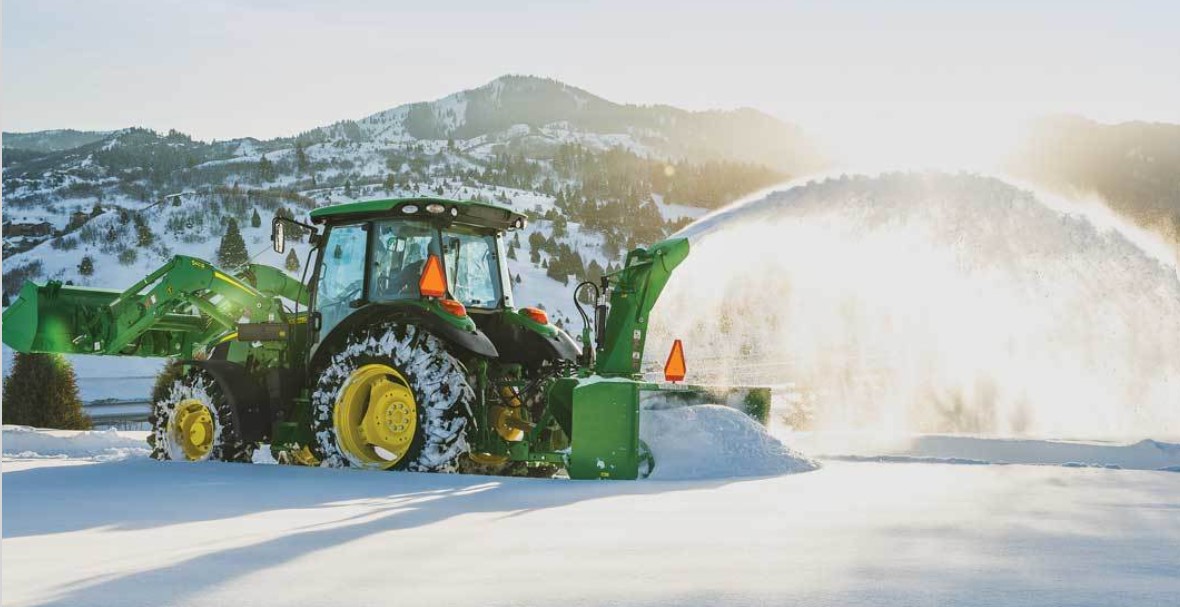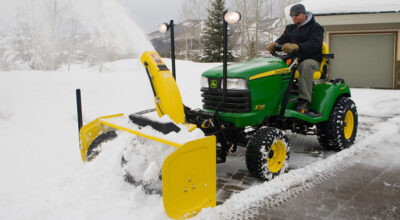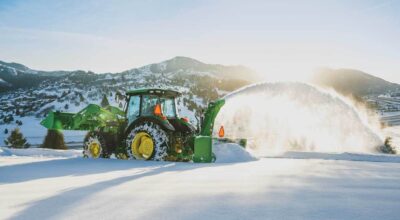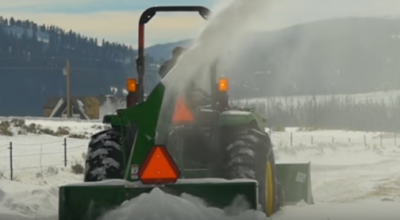Winter is synonymous with one thing: Snow. For many of us in regions that endure significant snowfall, we rely on our trusted snowblower to quickly clear away hard-to-remove snow and ice. However, failure to maintain your snowblower could result in costly breakdowns and reduce the overall lifespan of your equipment.
Before the first snowstorm of the season, it’s wise to prepare for winter by conducting a routine assessment of your snowblower. This involves more than adding gas and changing the oil, so you need a plan. By following a checklist, you can ensure your snowblower is ready for this winter season and stays in good shape for years to come.
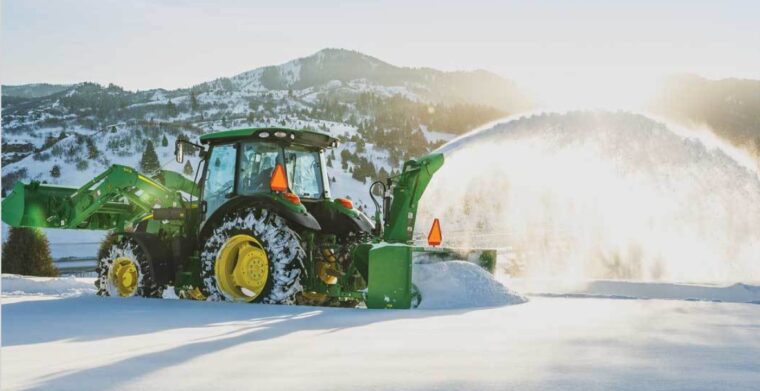
What is a John Deere Snowblower?
John Deere snow removal equipment is renowned for its durability, reliability, and ease of use and can support a wide range of needs and operation sizes. Currently, John Deere offers the Frontier SB series of snowblowers, which are available in a variety of attachment types, features, engine options, and clearing widths.
John Deere snow removal accessories, including the Frontier SB series, are available for your compact tractor and utility tractor, lawn tractor, gator UTV, or compact construction equipment and can be rear-mounted, front-mounted, or attached to loader arms depending on the type of vehicle and specific feature.
What are the Advantages of Considering Snowblower Maintenance?
Regular snowblower maintenance offers many benefits, in addition to making sure your machine starts when you need it most. Here are just a few:
Improved Performance
A well-maintained snowblower will start faster, run smoother, and clear snow more quickly and efficiently. This is because all of the moving parts are properly lubricated, and the engine is tuned to its optimal performance.
Prevents Breakdowns
The last thing you want during a snowstorm is for your snowblower to fail to start. Maintenance helps identify and address potential issues before they turn into major problems, preventing costly breakdowns.
Increased Efficiency
A well-maintained snowblower uses less fuel and oil, which can save you money over the long term. Additionally, a well-maintained snowblower is easier to operate and maneuver, which can help reduce operator fatigue.
Saves Money
By investing in regular maintenance, you can avoid expensive repairs down the road. Even small repairs can add up, so it’s worth it to keep your snowblower in good condition.
Extended Lifespan
By taking good care of your snowblower, you can extend its lifespan for many years. Regular maintenance helps to prevent excessive wear and tear on the machine’s parts, as well as the engine and other important components.
Prepare for the Snowy Season: 10 Snowblower Maintenance Tips
Now that you know the benefits of snowblower care, let’s dive into ten impactful maintenance tips that can prepare your snowblower for the start of the winter season:
1. Read the Manual
The first step in snowblower maintenance is to read the owner’s manual. This document contains essential information about your specific snowblower model, including maintenance schedules, safety precautions, and troubleshooting tips. Understanding your snowblower’s unique requirements is crucial for effective ongoing maintenance.
2. Check the Fuel System
If your snowblower is powered by gasoline, start by inspecting the fuel system. Check for any leaks and ensure that all fuel lines and connections are secure. It’s also a good practice to use a fuel stabilizer to keep the gas fresh and prevent clogs. Additionally, check the fuel tank for any debris or sediment that could affect performance.
3. Change the Oil
As with any gas-powered machinery, changing the oil is a fundamental part of snowblower maintenance. At the beginning of the season, check the oil level, drain the old oil, and replace it as recommended in your manual. Ensure that the oil level is within the recommended range and that there are no leaks around the oil plug.
4. Inspect the Spark Plug
A properly functioning spark plug is essential for easy starting and smooth operation. Remove the spark plug, inspect it for signs of wear, deposits, or damage, and replace it if necessary. Be sure not to overtighten the new spark plug when reinstalling it.
5. Clean or Replace the Air Filter
Many underestimate the importance of clean air filters. A clogged air filter restricts airflow to your engine, which can reduce efficiency and power. Be sure to remove the air filter and either clean it or replace it according to your snowblower’s maintenance schedule and its level of cleanliness.
6. Check the Belts and Auger
Inspect all belts and the auger for wear and damage. Two-stage snowblowers typically have two belts — one for the auger and one for the drive — while single-stage snowblowers have a single belt. Replace any worn or cracked belts promptly to avoid unexpected failures during use.
7. Lubricate Moving Parts
Proper lubrication is key to prevent excessive wear on moving parts. Consult your owner’s manual for guidance on which parts require lubrication and use recommended winter-grade lubricants. Common areas to lubricate include the chute rotation mechanism and the gearbox.
8. Test the Electric Starter (if applicable)
If your electric starter isn’t working properly, starting your snowblower in cold weather can be difficult or even impossible. To test the starter, simply start the snowblower as you normally would. If the starter is slow, doesn’t engage, or the engine doesn’t start, consult your snowblower’s owner’s manual for troubleshooting tips.
9. Check the Tire Pressure
Properly inflated tires provide better traction and stability, making your snowblower easier to maneuver and control in snowy conditions. To check your tire pressure, use a tire pressure gauge. The recommended tire pressure for your snowblower will be listed in your owner’s manual.
10. Store Properly
When the snow season ends, store your snowblower properly to keep it in good condition for the next winter. Let the machine cool down, clean it thoroughly, and store it in a dry, clean indoor area. If your snowblower runs on gasoline, follow the manufacturer’s instructions for storing the fuel system.
John Deere Snowblower FAQs
Does John Deere Still Make Walk-behind Snowblowers?
John Deere discontinued its line of walk-behind snowblowers in 2012, but the company still services and supports its customers’ existing walk-behind snowblowers. John Deere also continues to sell a variety of snow removal equipment, including tractor-mounted snowblowers and snow plows.
How Many Series Does a John Deere Snowblower Have?
John Deere currently offers the Frontier SB series of snowblowers, which come in a variety of attachment types, features, engine options, and clearing widths. John Deere also offers a variety of other snow removal equipment, such as snow pushers, front blades, spreaders, and tire chains. To find the right John Deere snow removal accessory for your needs, consult with a local John Deere dealer who can provide expert guidance based on your specific requirements.

Prepare for the Snowy Season with John Deere Snowblower
Proper maintenance not only extends the lifespan of your John Deere snowblower but also ensures that it performs at its best when you need it most. By following these ten maintenance tips, you can ensure that your snowblower is ready to tackle even the heaviest snowfalls.
To prepare for winter, visit your local John Deere dealer, who can help you maintain your current snowblower or help you find the right snow removal attachments for your operations. To find your nearest dealer, check out the John Deere locator.
If you enjoyed this post or want to read others, feel free to connect with us on Facebook, Pinterest, Twitter, or Instagram!
